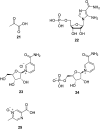Recent advances in small molecules for improving mitochondrial disorders
- PMID: 37435377
- PMCID: PMC10331567
- DOI: 10.1039/d3ra03313a
Recent advances in small molecules for improving mitochondrial disorders
Abstract
Mitochondrial disorders are observed in various human diseases, including rare genetic disorders and complex acquired pathologies. Recent advances in molecular biological techniques have dramatically expanded the understanding of multiple pathomechanisms involving mitochondrial disorders. However, the therapeutic methods for mitochondrial disorders are limited. For this reason, there is increasing interest in identifying safe and effective strategies to mitigate mitochondrial impairments. Small-molecule therapies hold promise for improving mitochondrial performance. This review focuses on the latest advances in developing bioactive compounds for treating mitochondrial disease, aiming to provide a broader perspective of fundamental studies that have been carried out to evaluate the effects of small molecules in regulating mitochondrial function. Novel-designed small molecules ameliorating mitochondrial functions are urgent for further research.
This journal is © The Royal Society of Chemistry.
Conflict of interest statement
The authors declare no other conflicts of interest.
Figures












Similar articles
-
Effects of (-)-epicatechin on mitochondria.Nutr Rev. 2021 Jan 1;79(1):25-41. doi: 10.1093/nutrit/nuaa094. Nutr Rev. 2021. PMID: 32989466 Review.
-
Clinical trials in mitochondrial disorders, an update.Mol Genet Metab. 2020 Sep-Oct;131(1-2):1-13. doi: 10.1016/j.ymgme.2020.10.002. Epub 2020 Oct 6. Mol Genet Metab. 2020. PMID: 33129691 Free PMC article. Review.
-
Bioactive molecules from terrestrial and seafood resources in hypertension treatment: focus on molecular mechanisms and targeted therapies.Nat Prod Bioprospect. 2023 Oct 30;13(1):45. doi: 10.1007/s13659-023-00411-1. Nat Prod Bioprospect. 2023. PMID: 37902881 Free PMC article. Review.
-
Mitochondrial disease in adults: recent advances and future promise.Lancet Neurol. 2021 Jul;20(7):573-584. doi: 10.1016/S1474-4422(21)00098-3. Lancet Neurol. 2021. PMID: 34146515 Review.
-
Mitochondrial Diseases: Hope for the Future.Cell. 2020 Apr 2;181(1):168-188. doi: 10.1016/j.cell.2020.02.051. Epub 2020 Mar 26. Cell. 2020. PMID: 32220313 Review.
Cited by
-
Advancements in PROTAC-based therapies for neurodegenerative diseases.Future Med Chem. 2025 Mar;17(5):591-605. doi: 10.1080/17568919.2025.2463310. Epub 2025 Feb 11. Future Med Chem. 2025. PMID: 39931801 Review.
-
Neuroinflammation: A Critical Factor in Neurodegenerative Disorders.Cureus. 2024 Jun 13;16(6):e62310. doi: 10.7759/cureus.62310. eCollection 2024 Jun. Cureus. 2024. PMID: 39006715 Free PMC article. Review.
-
The role of neuroinflammation in neurodegenerative diseases: current understanding and future therapeutic targets.Front Aging Neurosci. 2024 Apr 12;16:1347987. doi: 10.3389/fnagi.2024.1347987. eCollection 2024. Front Aging Neurosci. 2024. PMID: 38681666 Free PMC article. Review.
References
-
- Murphy M. P. Hartley R. C. Mitochondria as a therapeutic target for common pathologies. Nat. Rev. Drug Discov. 2018;17:865–886. - PubMed
-
- Kraus F. Roy K. Pucadyil T. J. Ryan M. T. Function and regulation of the divisome for mitochondrial fission. Nature. 2021;590:57–66. - PubMed
-
- Duchen M. R. Mitochondria in health and disease: perspectives on a new mitochondrial biology. Mol. Aspect. Med. 2004;25:365–451. - PubMed
-
- Neupane P. Bhuju S. Thapa N. Bhattarai H. K. ATP synthase:structure, function and inhibition. Biomol. Concepts. 2019;10:1–10. - PubMed
Publication types
LinkOut - more resources
Full Text Sources
Other Literature Sources

